Well-Child Assessment: Development, Outcomes and Teaching Strategies
VerifiedAdded on 2022/08/17
|19
|6131
|15
Case Study
AI Summary
This case study presents a well-child development assessment of a 15-year-old female, SG, focusing on her nutritional habits, developmental milestones, and physical development. The assessment reveals discrepancies between SG's self-perception and her parents' observations, particularly regarding her eating habits and exercise patterns. Nutritional and anthropometric analysis indicates that SG is underweight with a BMI at the 2nd percentile and is deficient in essential nutrients like iron and calcium. Milestone analysis explores her physical, social, and cognitive development, highlighting the influence of peer pressure and body image concerns. Safety and injury prevention strategies are also discussed, emphasizing the need for education and counseling to address potential risks associated with risky behaviors and peer influence. The study concludes by recommending pediatric nursing teaching strategies and future implications, emphasizing the importance of nutritional education, counseling, and family support to promote SG's overall well-being and healthy development. This document is available on Desklib, a platform providing a variety of study tools for students.
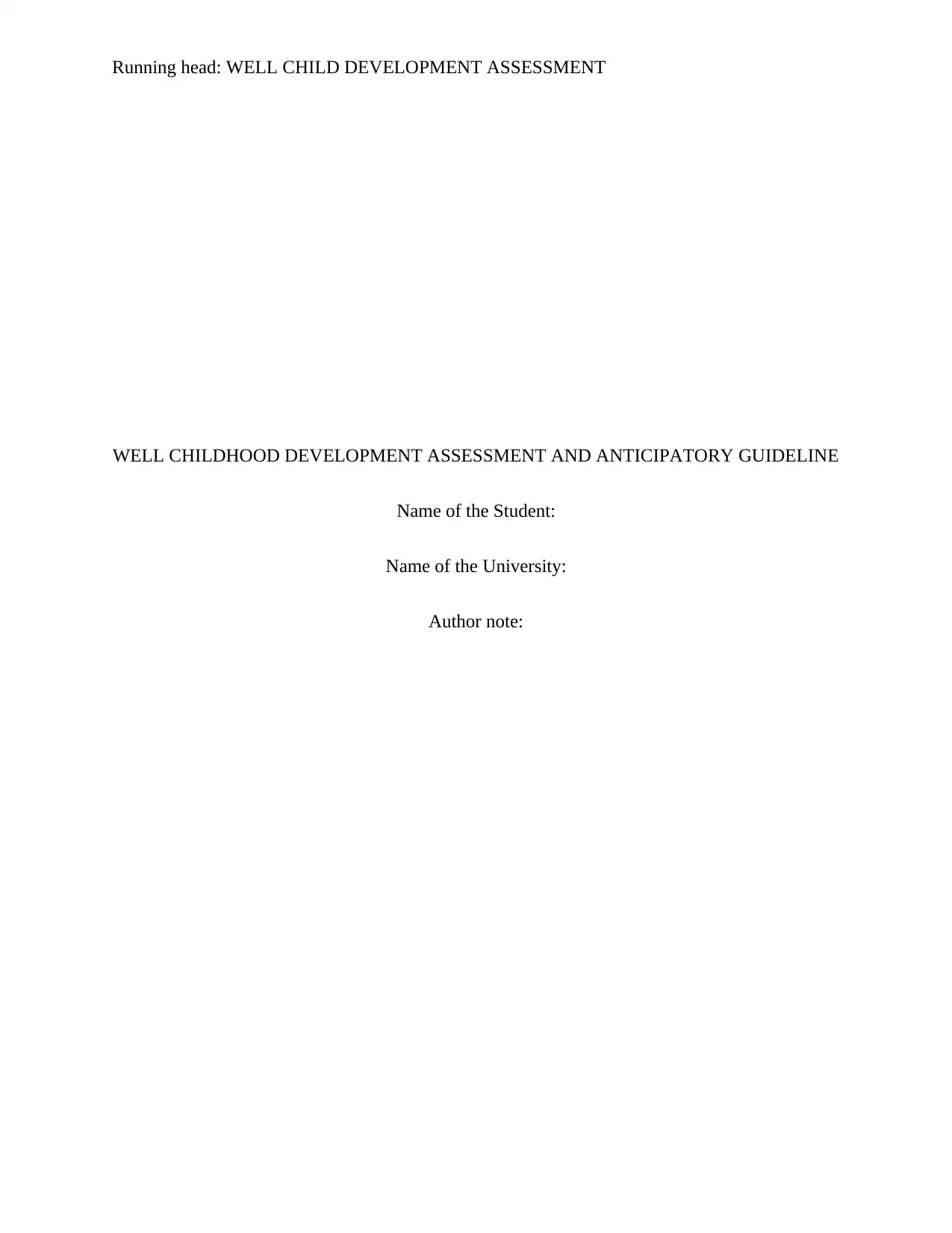
Running head: WELL CHILD DEVELOPMENT ASSESSMENT
WELL CHILDHOOD DEVELOPMENT ASSESSMENT AND ANTICIPATORY GUIDELINE
Name of the Student:
Name of the University:
Author note:
WELL CHILDHOOD DEVELOPMENT ASSESSMENT AND ANTICIPATORY GUIDELINE
Name of the Student:
Name of the University:
Author note:
Paraphrase This Document
Need a fresh take? Get an instant paraphrase of this document with our AI Paraphraser
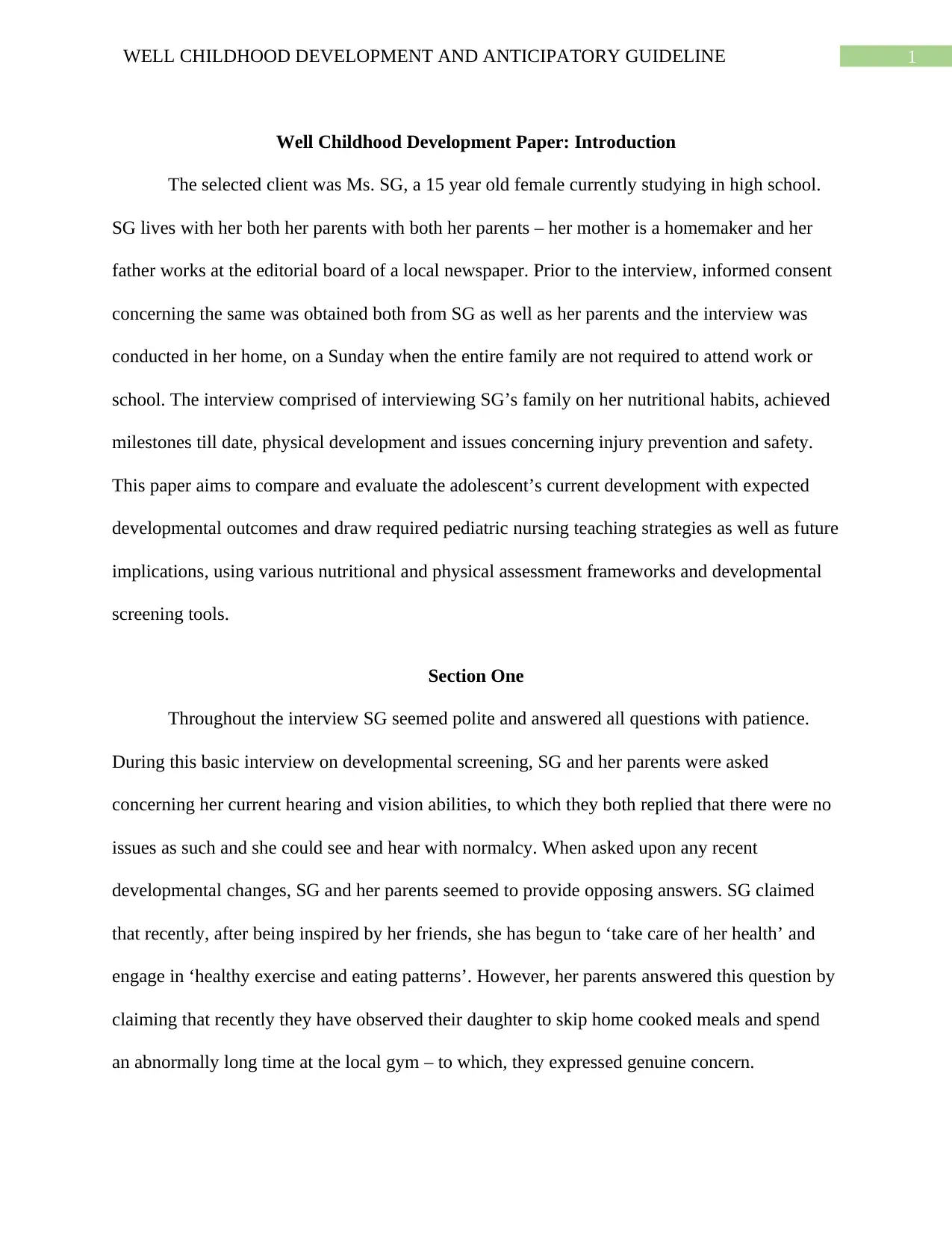
1WELL CHILDHOOD DEVELOPMENT AND ANTICIPATORY GUIDELINE
Well Childhood Development Paper: Introduction
The selected client was Ms. SG, a 15 year old female currently studying in high school.
SG lives with her both her parents with both her parents – her mother is a homemaker and her
father works at the editorial board of a local newspaper. Prior to the interview, informed consent
concerning the same was obtained both from SG as well as her parents and the interview was
conducted in her home, on a Sunday when the entire family are not required to attend work or
school. The interview comprised of interviewing SG’s family on her nutritional habits, achieved
milestones till date, physical development and issues concerning injury prevention and safety.
This paper aims to compare and evaluate the adolescent’s current development with expected
developmental outcomes and draw required pediatric nursing teaching strategies as well as future
implications, using various nutritional and physical assessment frameworks and developmental
screening tools.
Section One
Throughout the interview SG seemed polite and answered all questions with patience.
During this basic interview on developmental screening, SG and her parents were asked
concerning her current hearing and vision abilities, to which they both replied that there were no
issues as such and she could see and hear with normalcy. When asked upon any recent
developmental changes, SG and her parents seemed to provide opposing answers. SG claimed
that recently, after being inspired by her friends, she has begun to ‘take care of her health’ and
engage in ‘healthy exercise and eating patterns’. However, her parents answered this question by
claiming that recently they have observed their daughter to skip home cooked meals and spend
an abnormally long time at the local gym – to which, they expressed genuine concern.
Well Childhood Development Paper: Introduction
The selected client was Ms. SG, a 15 year old female currently studying in high school.
SG lives with her both her parents with both her parents – her mother is a homemaker and her
father works at the editorial board of a local newspaper. Prior to the interview, informed consent
concerning the same was obtained both from SG as well as her parents and the interview was
conducted in her home, on a Sunday when the entire family are not required to attend work or
school. The interview comprised of interviewing SG’s family on her nutritional habits, achieved
milestones till date, physical development and issues concerning injury prevention and safety.
This paper aims to compare and evaluate the adolescent’s current development with expected
developmental outcomes and draw required pediatric nursing teaching strategies as well as future
implications, using various nutritional and physical assessment frameworks and developmental
screening tools.
Section One
Throughout the interview SG seemed polite and answered all questions with patience.
During this basic interview on developmental screening, SG and her parents were asked
concerning her current hearing and vision abilities, to which they both replied that there were no
issues as such and she could see and hear with normalcy. When asked upon any recent
developmental changes, SG and her parents seemed to provide opposing answers. SG claimed
that recently, after being inspired by her friends, she has begun to ‘take care of her health’ and
engage in ‘healthy exercise and eating patterns’. However, her parents answered this question by
claiming that recently they have observed their daughter to skip home cooked meals and spend
an abnormally long time at the local gym – to which, they expressed genuine concern.
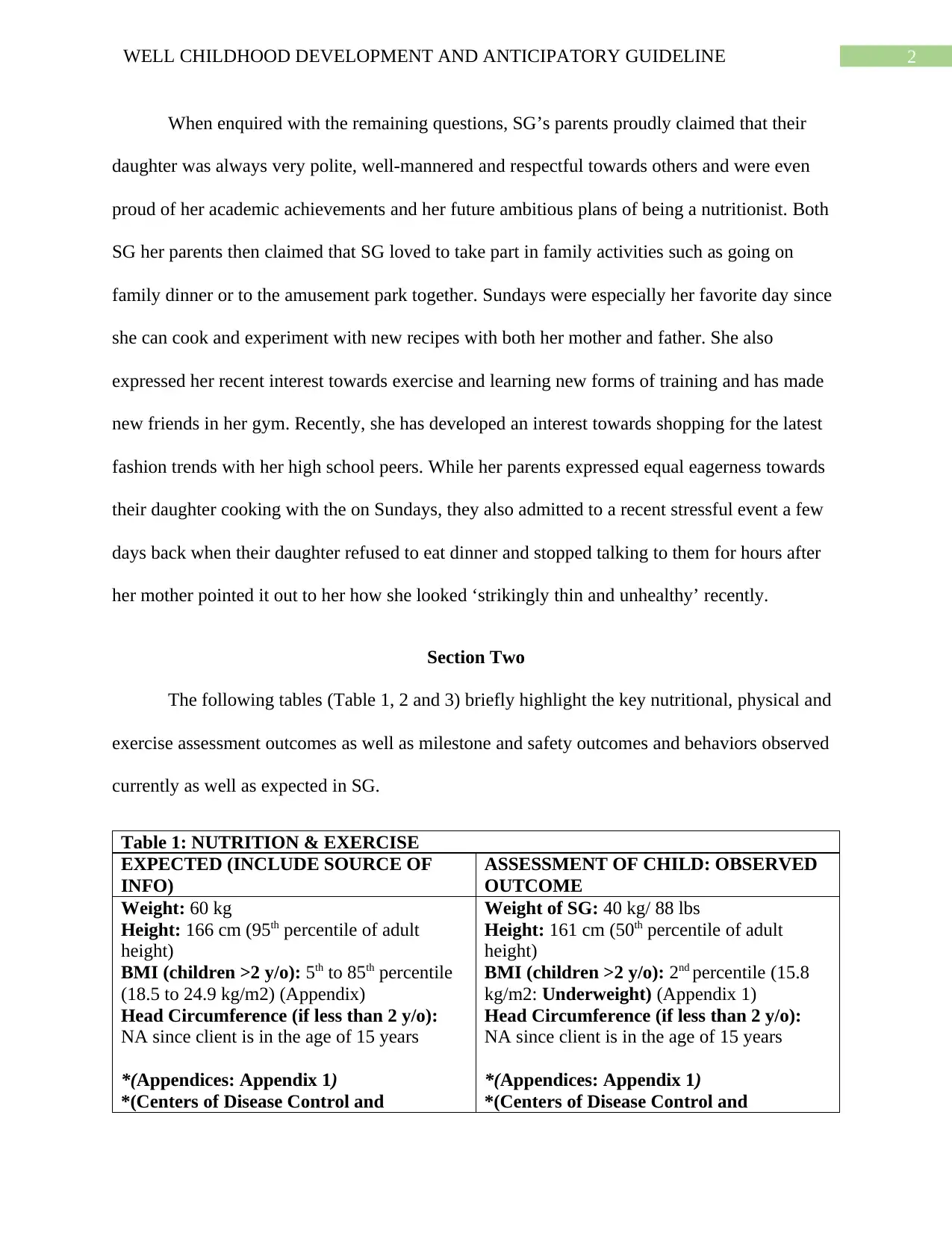
2WELL CHILDHOOD DEVELOPMENT AND ANTICIPATORY GUIDELINE
When enquired with the remaining questions, SG’s parents proudly claimed that their
daughter was always very polite, well-mannered and respectful towards others and were even
proud of her academic achievements and her future ambitious plans of being a nutritionist. Both
SG her parents then claimed that SG loved to take part in family activities such as going on
family dinner or to the amusement park together. Sundays were especially her favorite day since
she can cook and experiment with new recipes with both her mother and father. She also
expressed her recent interest towards exercise and learning new forms of training and has made
new friends in her gym. Recently, she has developed an interest towards shopping for the latest
fashion trends with her high school peers. While her parents expressed equal eagerness towards
their daughter cooking with the on Sundays, they also admitted to a recent stressful event a few
days back when their daughter refused to eat dinner and stopped talking to them for hours after
her mother pointed it out to her how she looked ‘strikingly thin and unhealthy’ recently.
Section Two
The following tables (Table 1, 2 and 3) briefly highlight the key nutritional, physical and
exercise assessment outcomes as well as milestone and safety outcomes and behaviors observed
currently as well as expected in SG.
Table 1: NUTRITION & EXERCISE
EXPECTED (INCLUDE SOURCE OF
INFO)
ASSESSMENT OF CHILD: OBSERVED
OUTCOME
Weight: 60 kg
Height: 166 cm (95th percentile of adult
height)
BMI (children >2 y/o): 5th to 85th percentile
(18.5 to 24.9 kg/m2) (Appendix)
Head Circumference (if less than 2 y/o):
NA since client is in the age of 15 years
*(Appendices: Appendix 1)
*(Centers of Disease Control and
Weight of SG: 40 kg/ 88 lbs
Height: 161 cm (50th percentile of adult
height)
BMI (children >2 y/o): 2nd percentile (15.8
kg/m2: Underweight) (Appendix 1)
Head Circumference (if less than 2 y/o):
NA since client is in the age of 15 years
*(Appendices: Appendix 1)
*(Centers of Disease Control and
When enquired with the remaining questions, SG’s parents proudly claimed that their
daughter was always very polite, well-mannered and respectful towards others and were even
proud of her academic achievements and her future ambitious plans of being a nutritionist. Both
SG her parents then claimed that SG loved to take part in family activities such as going on
family dinner or to the amusement park together. Sundays were especially her favorite day since
she can cook and experiment with new recipes with both her mother and father. She also
expressed her recent interest towards exercise and learning new forms of training and has made
new friends in her gym. Recently, she has developed an interest towards shopping for the latest
fashion trends with her high school peers. While her parents expressed equal eagerness towards
their daughter cooking with the on Sundays, they also admitted to a recent stressful event a few
days back when their daughter refused to eat dinner and stopped talking to them for hours after
her mother pointed it out to her how she looked ‘strikingly thin and unhealthy’ recently.
Section Two
The following tables (Table 1, 2 and 3) briefly highlight the key nutritional, physical and
exercise assessment outcomes as well as milestone and safety outcomes and behaviors observed
currently as well as expected in SG.
Table 1: NUTRITION & EXERCISE
EXPECTED (INCLUDE SOURCE OF
INFO)
ASSESSMENT OF CHILD: OBSERVED
OUTCOME
Weight: 60 kg
Height: 166 cm (95th percentile of adult
height)
BMI (children >2 y/o): 5th to 85th percentile
(18.5 to 24.9 kg/m2) (Appendix)
Head Circumference (if less than 2 y/o):
NA since client is in the age of 15 years
*(Appendices: Appendix 1)
*(Centers of Disease Control and
Weight of SG: 40 kg/ 88 lbs
Height: 161 cm (50th percentile of adult
height)
BMI (children >2 y/o): 2nd percentile (15.8
kg/m2: Underweight) (Appendix 1)
Head Circumference (if less than 2 y/o):
NA since client is in the age of 15 years
*(Appendices: Appendix 1)
*(Centers of Disease Control and
⊘ This is a preview!⊘
Do you want full access?
Subscribe today to unlock all pages.

Trusted by 1+ million students worldwide
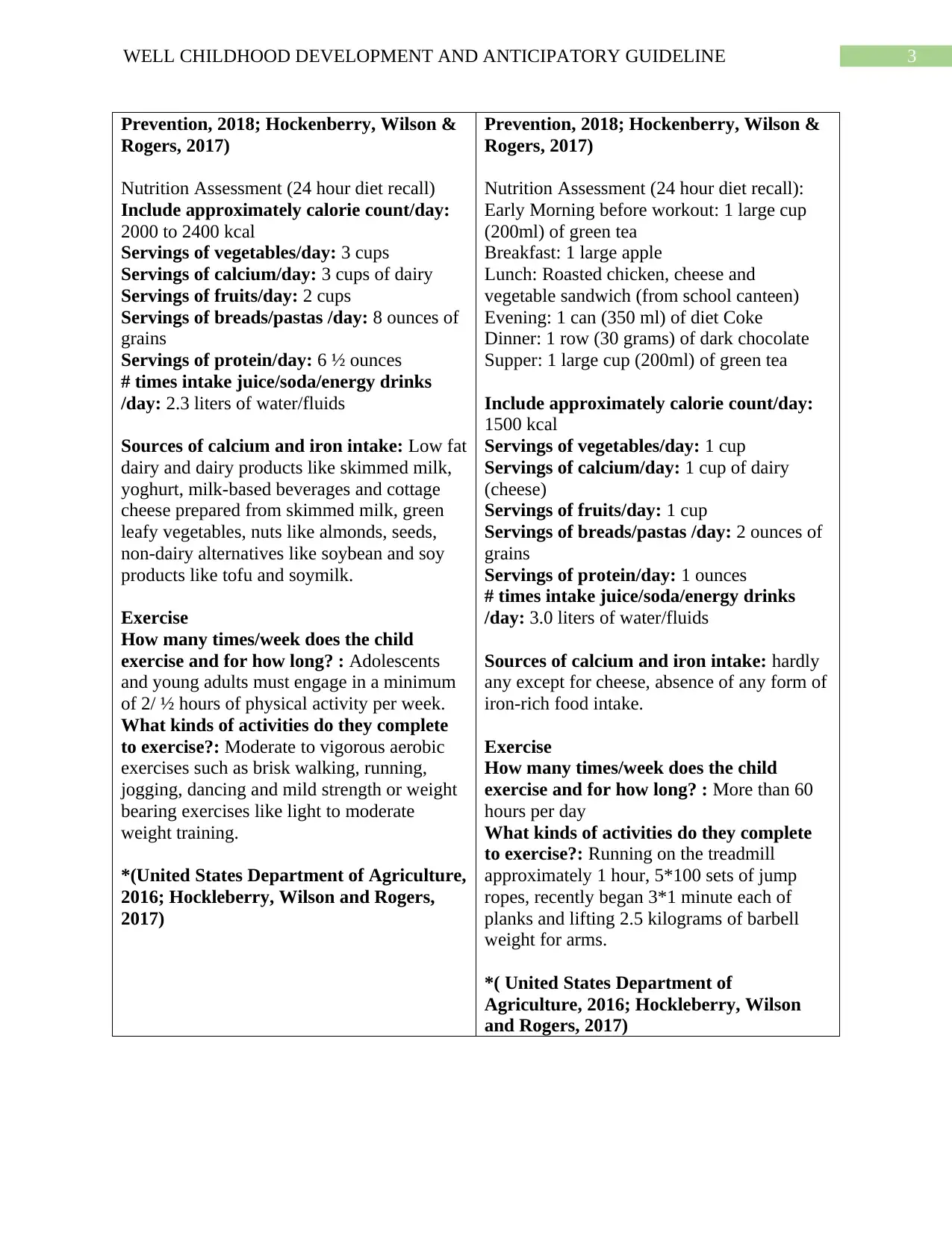
3WELL CHILDHOOD DEVELOPMENT AND ANTICIPATORY GUIDELINE
Prevention, 2018; Hockenberry, Wilson &
Rogers, 2017)
Nutrition Assessment (24 hour diet recall)
Include approximately calorie count/day:
2000 to 2400 kcal
Servings of vegetables/day: 3 cups
Servings of calcium/day: 3 cups of dairy
Servings of fruits/day: 2 cups
Servings of breads/pastas /day: 8 ounces of
grains
Servings of protein/day: 6 ½ ounces
# times intake juice/soda/energy drinks
/day: 2.3 liters of water/fluids
Sources of calcium and iron intake: Low fat
dairy and dairy products like skimmed milk,
yoghurt, milk-based beverages and cottage
cheese prepared from skimmed milk, green
leafy vegetables, nuts like almonds, seeds,
non-dairy alternatives like soybean and soy
products like tofu and soymilk.
Exercise
How many times/week does the child
exercise and for how long? : Adolescents
and young adults must engage in a minimum
of 2/ ½ hours of physical activity per week.
What kinds of activities do they complete
to exercise?: Moderate to vigorous aerobic
exercises such as brisk walking, running,
jogging, dancing and mild strength or weight
bearing exercises like light to moderate
weight training.
*(United States Department of Agriculture,
2016; Hockleberry, Wilson and Rogers,
2017)
Prevention, 2018; Hockenberry, Wilson &
Rogers, 2017)
Nutrition Assessment (24 hour diet recall):
Early Morning before workout: 1 large cup
(200ml) of green tea
Breakfast: 1 large apple
Lunch: Roasted chicken, cheese and
vegetable sandwich (from school canteen)
Evening: 1 can (350 ml) of diet Coke
Dinner: 1 row (30 grams) of dark chocolate
Supper: 1 large cup (200ml) of green tea
Include approximately calorie count/day:
1500 kcal
Servings of vegetables/day: 1 cup
Servings of calcium/day: 1 cup of dairy
(cheese)
Servings of fruits/day: 1 cup
Servings of breads/pastas /day: 2 ounces of
grains
Servings of protein/day: 1 ounces
# times intake juice/soda/energy drinks
/day: 3.0 liters of water/fluids
Sources of calcium and iron intake: hardly
any except for cheese, absence of any form of
iron-rich food intake.
Exercise
How many times/week does the child
exercise and for how long? : More than 60
hours per day
What kinds of activities do they complete
to exercise?: Running on the treadmill
approximately 1 hour, 5*100 sets of jump
ropes, recently began 3*1 minute each of
planks and lifting 2.5 kilograms of barbell
weight for arms.
*( United States Department of
Agriculture, 2016; Hockleberry, Wilson
and Rogers, 2017)
Prevention, 2018; Hockenberry, Wilson &
Rogers, 2017)
Nutrition Assessment (24 hour diet recall)
Include approximately calorie count/day:
2000 to 2400 kcal
Servings of vegetables/day: 3 cups
Servings of calcium/day: 3 cups of dairy
Servings of fruits/day: 2 cups
Servings of breads/pastas /day: 8 ounces of
grains
Servings of protein/day: 6 ½ ounces
# times intake juice/soda/energy drinks
/day: 2.3 liters of water/fluids
Sources of calcium and iron intake: Low fat
dairy and dairy products like skimmed milk,
yoghurt, milk-based beverages and cottage
cheese prepared from skimmed milk, green
leafy vegetables, nuts like almonds, seeds,
non-dairy alternatives like soybean and soy
products like tofu and soymilk.
Exercise
How many times/week does the child
exercise and for how long? : Adolescents
and young adults must engage in a minimum
of 2/ ½ hours of physical activity per week.
What kinds of activities do they complete
to exercise?: Moderate to vigorous aerobic
exercises such as brisk walking, running,
jogging, dancing and mild strength or weight
bearing exercises like light to moderate
weight training.
*(United States Department of Agriculture,
2016; Hockleberry, Wilson and Rogers,
2017)
Prevention, 2018; Hockenberry, Wilson &
Rogers, 2017)
Nutrition Assessment (24 hour diet recall):
Early Morning before workout: 1 large cup
(200ml) of green tea
Breakfast: 1 large apple
Lunch: Roasted chicken, cheese and
vegetable sandwich (from school canteen)
Evening: 1 can (350 ml) of diet Coke
Dinner: 1 row (30 grams) of dark chocolate
Supper: 1 large cup (200ml) of green tea
Include approximately calorie count/day:
1500 kcal
Servings of vegetables/day: 1 cup
Servings of calcium/day: 1 cup of dairy
(cheese)
Servings of fruits/day: 1 cup
Servings of breads/pastas /day: 2 ounces of
grains
Servings of protein/day: 1 ounces
# times intake juice/soda/energy drinks
/day: 3.0 liters of water/fluids
Sources of calcium and iron intake: hardly
any except for cheese, absence of any form of
iron-rich food intake.
Exercise
How many times/week does the child
exercise and for how long? : More than 60
hours per day
What kinds of activities do they complete
to exercise?: Running on the treadmill
approximately 1 hour, 5*100 sets of jump
ropes, recently began 3*1 minute each of
planks and lifting 2.5 kilograms of barbell
weight for arms.
*( United States Department of
Agriculture, 2016; Hockleberry, Wilson
and Rogers, 2017)
Paraphrase This Document
Need a fresh take? Get an instant paraphrase of this document with our AI Paraphraser
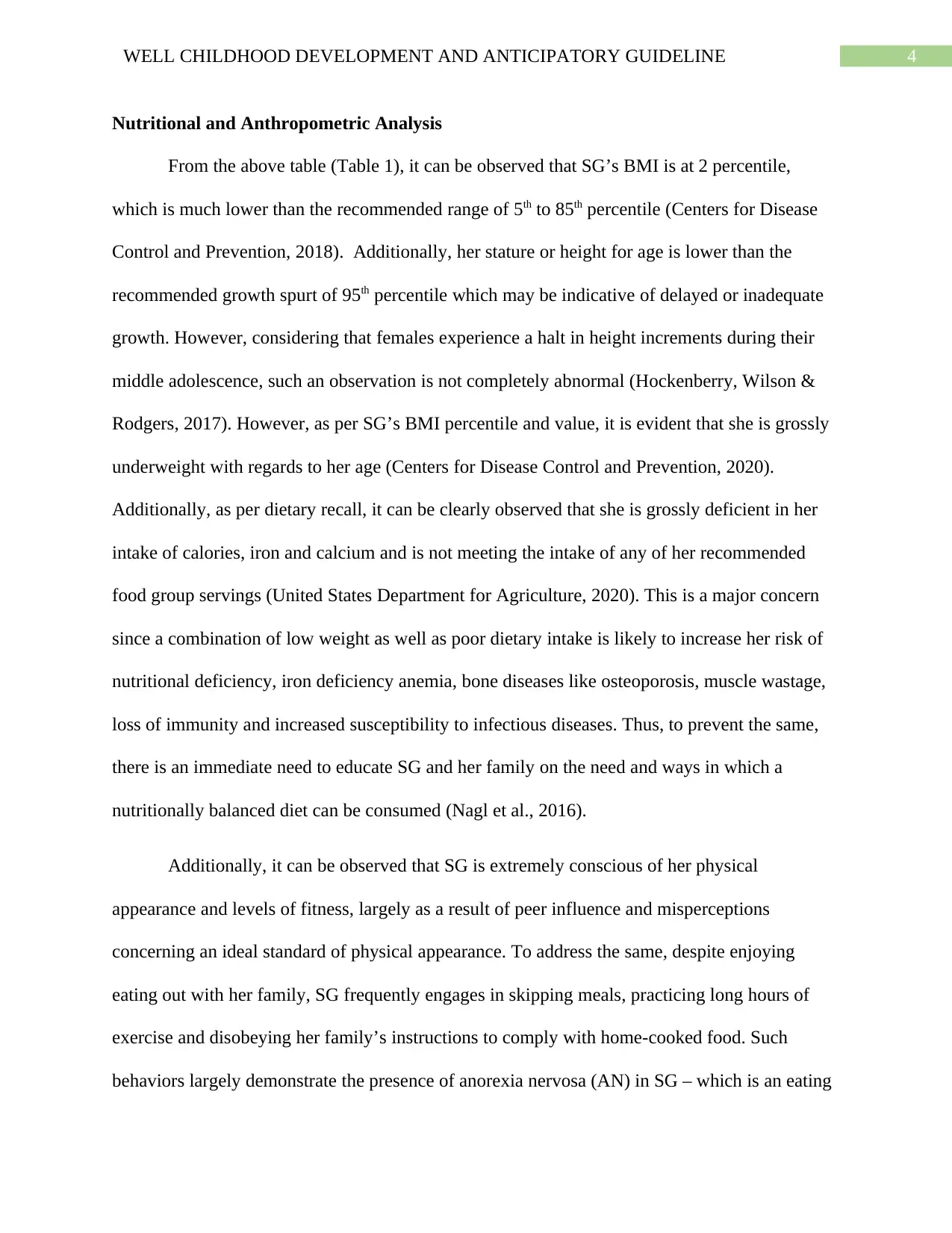
4WELL CHILDHOOD DEVELOPMENT AND ANTICIPATORY GUIDELINE
Nutritional and Anthropometric Analysis
From the above table (Table 1), it can be observed that SG’s BMI is at 2 percentile,
which is much lower than the recommended range of 5th to 85th percentile (Centers for Disease
Control and Prevention, 2018). Additionally, her stature or height for age is lower than the
recommended growth spurt of 95th percentile which may be indicative of delayed or inadequate
growth. However, considering that females experience a halt in height increments during their
middle adolescence, such an observation is not completely abnormal (Hockenberry, Wilson &
Rodgers, 2017). However, as per SG’s BMI percentile and value, it is evident that she is grossly
underweight with regards to her age (Centers for Disease Control and Prevention, 2020).
Additionally, as per dietary recall, it can be clearly observed that she is grossly deficient in her
intake of calories, iron and calcium and is not meeting the intake of any of her recommended
food group servings (United States Department for Agriculture, 2020). This is a major concern
since a combination of low weight as well as poor dietary intake is likely to increase her risk of
nutritional deficiency, iron deficiency anemia, bone diseases like osteoporosis, muscle wastage,
loss of immunity and increased susceptibility to infectious diseases. Thus, to prevent the same,
there is an immediate need to educate SG and her family on the need and ways in which a
nutritionally balanced diet can be consumed (Nagl et al., 2016).
Additionally, it can be observed that SG is extremely conscious of her physical
appearance and levels of fitness, largely as a result of peer influence and misperceptions
concerning an ideal standard of physical appearance. To address the same, despite enjoying
eating out with her family, SG frequently engages in skipping meals, practicing long hours of
exercise and disobeying her family’s instructions to comply with home-cooked food. Such
behaviors largely demonstrate the presence of anorexia nervosa (AN) in SG – which is an eating
Nutritional and Anthropometric Analysis
From the above table (Table 1), it can be observed that SG’s BMI is at 2 percentile,
which is much lower than the recommended range of 5th to 85th percentile (Centers for Disease
Control and Prevention, 2018). Additionally, her stature or height for age is lower than the
recommended growth spurt of 95th percentile which may be indicative of delayed or inadequate
growth. However, considering that females experience a halt in height increments during their
middle adolescence, such an observation is not completely abnormal (Hockenberry, Wilson &
Rodgers, 2017). However, as per SG’s BMI percentile and value, it is evident that she is grossly
underweight with regards to her age (Centers for Disease Control and Prevention, 2020).
Additionally, as per dietary recall, it can be clearly observed that she is grossly deficient in her
intake of calories, iron and calcium and is not meeting the intake of any of her recommended
food group servings (United States Department for Agriculture, 2020). This is a major concern
since a combination of low weight as well as poor dietary intake is likely to increase her risk of
nutritional deficiency, iron deficiency anemia, bone diseases like osteoporosis, muscle wastage,
loss of immunity and increased susceptibility to infectious diseases. Thus, to prevent the same,
there is an immediate need to educate SG and her family on the need and ways in which a
nutritionally balanced diet can be consumed (Nagl et al., 2016).
Additionally, it can be observed that SG is extremely conscious of her physical
appearance and levels of fitness, largely as a result of peer influence and misperceptions
concerning an ideal standard of physical appearance. To address the same, despite enjoying
eating out with her family, SG frequently engages in skipping meals, practicing long hours of
exercise and disobeying her family’s instructions to comply with home-cooked food. Such
behaviors largely demonstrate the presence of anorexia nervosa (AN) in SG – which is an eating
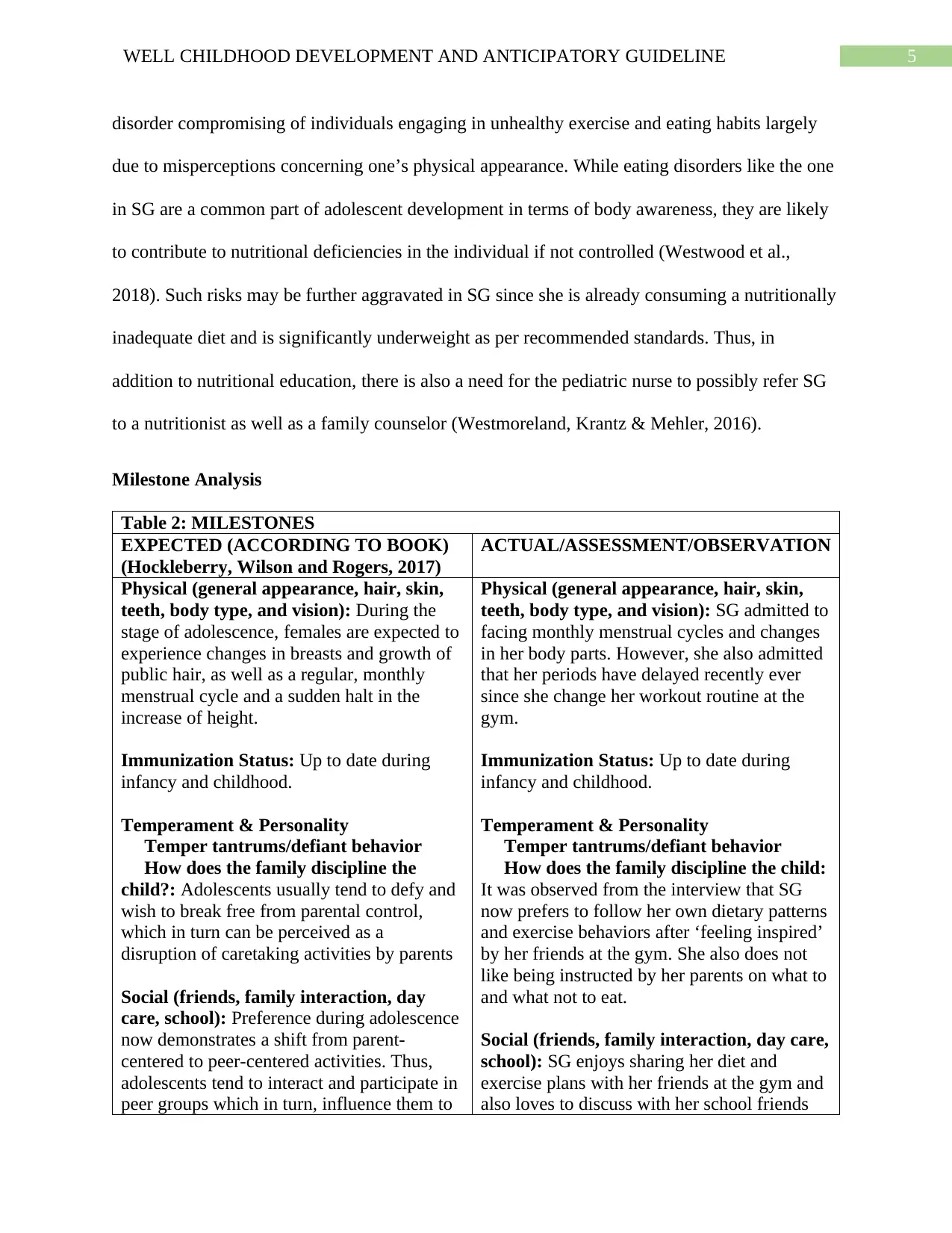
5WELL CHILDHOOD DEVELOPMENT AND ANTICIPATORY GUIDELINE
disorder compromising of individuals engaging in unhealthy exercise and eating habits largely
due to misperceptions concerning one’s physical appearance. While eating disorders like the one
in SG are a common part of adolescent development in terms of body awareness, they are likely
to contribute to nutritional deficiencies in the individual if not controlled (Westwood et al.,
2018). Such risks may be further aggravated in SG since she is already consuming a nutritionally
inadequate diet and is significantly underweight as per recommended standards. Thus, in
addition to nutritional education, there is also a need for the pediatric nurse to possibly refer SG
to a nutritionist as well as a family counselor (Westmoreland, Krantz & Mehler, 2016).
Milestone Analysis
Table 2: MILESTONES
EXPECTED (ACCORDING TO BOOK)
(Hockleberry, Wilson and Rogers, 2017)
ACTUAL/ASSESSMENT/OBSERVATION
Physical (general appearance, hair, skin,
teeth, body type, and vision): During the
stage of adolescence, females are expected to
experience changes in breasts and growth of
public hair, as well as a regular, monthly
menstrual cycle and a sudden halt in the
increase of height.
Immunization Status: Up to date during
infancy and childhood.
Temperament & Personality
Temper tantrums/defiant behavior
How does the family discipline the
child?: Adolescents usually tend to defy and
wish to break free from parental control,
which in turn can be perceived as a
disruption of caretaking activities by parents
Social (friends, family interaction, day
care, school): Preference during adolescence
now demonstrates a shift from parent-
centered to peer-centered activities. Thus,
adolescents tend to interact and participate in
peer groups which in turn, influence them to
Physical (general appearance, hair, skin,
teeth, body type, and vision): SG admitted to
facing monthly menstrual cycles and changes
in her body parts. However, she also admitted
that her periods have delayed recently ever
since she change her workout routine at the
gym.
Immunization Status: Up to date during
infancy and childhood.
Temperament & Personality
Temper tantrums/defiant behavior
How does the family discipline the child:
It was observed from the interview that SG
now prefers to follow her own dietary patterns
and exercise behaviors after ‘feeling inspired’
by her friends at the gym. She also does not
like being instructed by her parents on what to
and what not to eat.
Social (friends, family interaction, day care,
school): SG enjoys sharing her diet and
exercise plans with her friends at the gym and
also loves to discuss with her school friends
disorder compromising of individuals engaging in unhealthy exercise and eating habits largely
due to misperceptions concerning one’s physical appearance. While eating disorders like the one
in SG are a common part of adolescent development in terms of body awareness, they are likely
to contribute to nutritional deficiencies in the individual if not controlled (Westwood et al.,
2018). Such risks may be further aggravated in SG since she is already consuming a nutritionally
inadequate diet and is significantly underweight as per recommended standards. Thus, in
addition to nutritional education, there is also a need for the pediatric nurse to possibly refer SG
to a nutritionist as well as a family counselor (Westmoreland, Krantz & Mehler, 2016).
Milestone Analysis
Table 2: MILESTONES
EXPECTED (ACCORDING TO BOOK)
(Hockleberry, Wilson and Rogers, 2017)
ACTUAL/ASSESSMENT/OBSERVATION
Physical (general appearance, hair, skin,
teeth, body type, and vision): During the
stage of adolescence, females are expected to
experience changes in breasts and growth of
public hair, as well as a regular, monthly
menstrual cycle and a sudden halt in the
increase of height.
Immunization Status: Up to date during
infancy and childhood.
Temperament & Personality
Temper tantrums/defiant behavior
How does the family discipline the
child?: Adolescents usually tend to defy and
wish to break free from parental control,
which in turn can be perceived as a
disruption of caretaking activities by parents
Social (friends, family interaction, day
care, school): Preference during adolescence
now demonstrates a shift from parent-
centered to peer-centered activities. Thus,
adolescents tend to interact and participate in
peer groups which in turn, influence them to
Physical (general appearance, hair, skin,
teeth, body type, and vision): SG admitted to
facing monthly menstrual cycles and changes
in her body parts. However, she also admitted
that her periods have delayed recently ever
since she change her workout routine at the
gym.
Immunization Status: Up to date during
infancy and childhood.
Temperament & Personality
Temper tantrums/defiant behavior
How does the family discipline the child:
It was observed from the interview that SG
now prefers to follow her own dietary patterns
and exercise behaviors after ‘feeling inspired’
by her friends at the gym. She also does not
like being instructed by her parents on what to
and what not to eat.
Social (friends, family interaction, day care,
school): SG enjoys sharing her diet and
exercise plans with her friends at the gym and
also loves to discuss with her school friends
⊘ This is a preview!⊘
Do you want full access?
Subscribe today to unlock all pages.

Trusted by 1+ million students worldwide
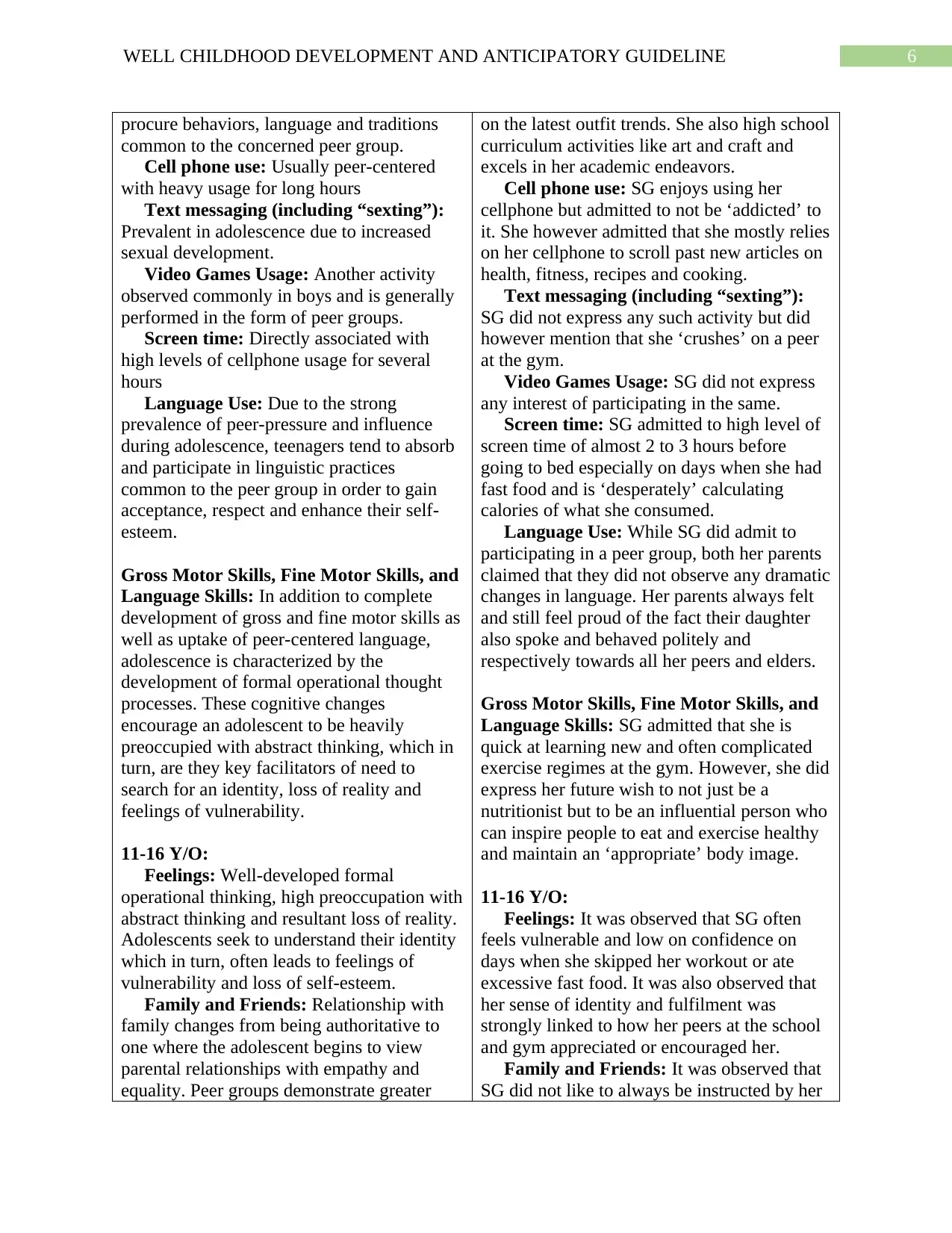
6WELL CHILDHOOD DEVELOPMENT AND ANTICIPATORY GUIDELINE
procure behaviors, language and traditions
common to the concerned peer group.
Cell phone use: Usually peer-centered
with heavy usage for long hours
Text messaging (including “sexting”):
Prevalent in adolescence due to increased
sexual development.
Video Games Usage: Another activity
observed commonly in boys and is generally
performed in the form of peer groups.
Screen time: Directly associated with
high levels of cellphone usage for several
hours
Language Use: Due to the strong
prevalence of peer-pressure and influence
during adolescence, teenagers tend to absorb
and participate in linguistic practices
common to the peer group in order to gain
acceptance, respect and enhance their self-
esteem.
Gross Motor Skills, Fine Motor Skills, and
Language Skills: In addition to complete
development of gross and fine motor skills as
well as uptake of peer-centered language,
adolescence is characterized by the
development of formal operational thought
processes. These cognitive changes
encourage an adolescent to be heavily
preoccupied with abstract thinking, which in
turn, are they key facilitators of need to
search for an identity, loss of reality and
feelings of vulnerability.
11-16 Y/O:
Feelings: Well-developed formal
operational thinking, high preoccupation with
abstract thinking and resultant loss of reality.
Adolescents seek to understand their identity
which in turn, often leads to feelings of
vulnerability and loss of self-esteem.
Family and Friends: Relationship with
family changes from being authoritative to
one where the adolescent begins to view
parental relationships with empathy and
equality. Peer groups demonstrate greater
on the latest outfit trends. She also high school
curriculum activities like art and craft and
excels in her academic endeavors.
Cell phone use: SG enjoys using her
cellphone but admitted to not be ‘addicted’ to
it. She however admitted that she mostly relies
on her cellphone to scroll past new articles on
health, fitness, recipes and cooking.
Text messaging (including “sexting”):
SG did not express any such activity but did
however mention that she ‘crushes’ on a peer
at the gym.
Video Games Usage: SG did not express
any interest of participating in the same.
Screen time: SG admitted to high level of
screen time of almost 2 to 3 hours before
going to bed especially on days when she had
fast food and is ‘desperately’ calculating
calories of what she consumed.
Language Use: While SG did admit to
participating in a peer group, both her parents
claimed that they did not observe any dramatic
changes in language. Her parents always felt
and still feel proud of the fact their daughter
also spoke and behaved politely and
respectively towards all her peers and elders.
Gross Motor Skills, Fine Motor Skills, and
Language Skills: SG admitted that she is
quick at learning new and often complicated
exercise regimes at the gym. However, she did
express her future wish to not just be a
nutritionist but to be an influential person who
can inspire people to eat and exercise healthy
and maintain an ‘appropriate’ body image.
11-16 Y/O:
Feelings: It was observed that SG often
feels vulnerable and low on confidence on
days when she skipped her workout or ate
excessive fast food. It was also observed that
her sense of identity and fulfilment was
strongly linked to how her peers at the school
and gym appreciated or encouraged her.
Family and Friends: It was observed that
SG did not like to always be instructed by her
procure behaviors, language and traditions
common to the concerned peer group.
Cell phone use: Usually peer-centered
with heavy usage for long hours
Text messaging (including “sexting”):
Prevalent in adolescence due to increased
sexual development.
Video Games Usage: Another activity
observed commonly in boys and is generally
performed in the form of peer groups.
Screen time: Directly associated with
high levels of cellphone usage for several
hours
Language Use: Due to the strong
prevalence of peer-pressure and influence
during adolescence, teenagers tend to absorb
and participate in linguistic practices
common to the peer group in order to gain
acceptance, respect and enhance their self-
esteem.
Gross Motor Skills, Fine Motor Skills, and
Language Skills: In addition to complete
development of gross and fine motor skills as
well as uptake of peer-centered language,
adolescence is characterized by the
development of formal operational thought
processes. These cognitive changes
encourage an adolescent to be heavily
preoccupied with abstract thinking, which in
turn, are they key facilitators of need to
search for an identity, loss of reality and
feelings of vulnerability.
11-16 Y/O:
Feelings: Well-developed formal
operational thinking, high preoccupation with
abstract thinking and resultant loss of reality.
Adolescents seek to understand their identity
which in turn, often leads to feelings of
vulnerability and loss of self-esteem.
Family and Friends: Relationship with
family changes from being authoritative to
one where the adolescent begins to view
parental relationships with empathy and
equality. Peer groups demonstrate greater
on the latest outfit trends. She also high school
curriculum activities like art and craft and
excels in her academic endeavors.
Cell phone use: SG enjoys using her
cellphone but admitted to not be ‘addicted’ to
it. She however admitted that she mostly relies
on her cellphone to scroll past new articles on
health, fitness, recipes and cooking.
Text messaging (including “sexting”):
SG did not express any such activity but did
however mention that she ‘crushes’ on a peer
at the gym.
Video Games Usage: SG did not express
any interest of participating in the same.
Screen time: SG admitted to high level of
screen time of almost 2 to 3 hours before
going to bed especially on days when she had
fast food and is ‘desperately’ calculating
calories of what she consumed.
Language Use: While SG did admit to
participating in a peer group, both her parents
claimed that they did not observe any dramatic
changes in language. Her parents always felt
and still feel proud of the fact their daughter
also spoke and behaved politely and
respectively towards all her peers and elders.
Gross Motor Skills, Fine Motor Skills, and
Language Skills: SG admitted that she is
quick at learning new and often complicated
exercise regimes at the gym. However, she did
express her future wish to not just be a
nutritionist but to be an influential person who
can inspire people to eat and exercise healthy
and maintain an ‘appropriate’ body image.
11-16 Y/O:
Feelings: It was observed that SG often
feels vulnerable and low on confidence on
days when she skipped her workout or ate
excessive fast food. It was also observed that
her sense of identity and fulfilment was
strongly linked to how her peers at the school
and gym appreciated or encouraged her.
Family and Friends: It was observed that
SG did not like to always be instructed by her
Paraphrase This Document
Need a fresh take? Get an instant paraphrase of this document with our AI Paraphraser
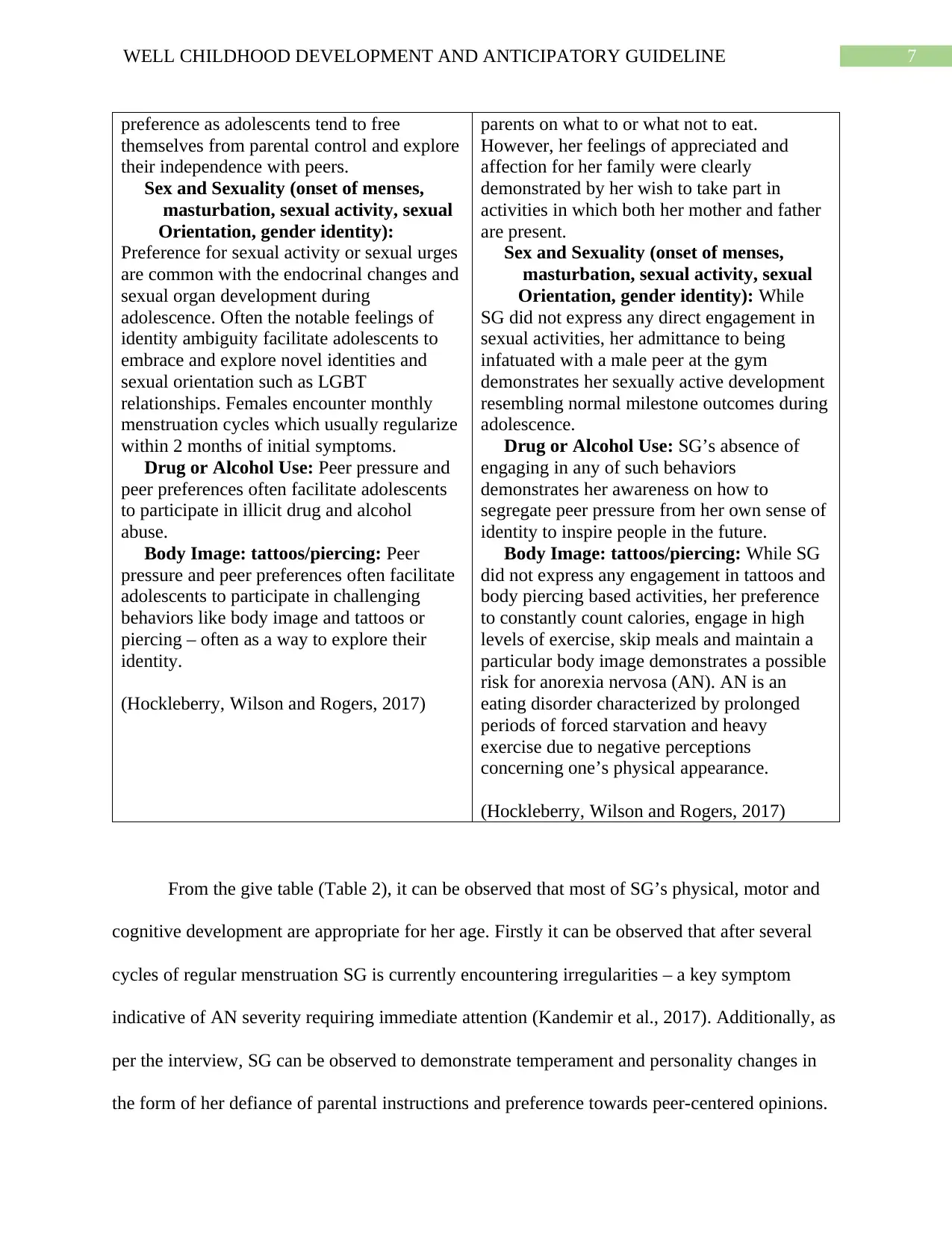
7WELL CHILDHOOD DEVELOPMENT AND ANTICIPATORY GUIDELINE
preference as adolescents tend to free
themselves from parental control and explore
their independence with peers.
Sex and Sexuality (onset of menses,
masturbation, sexual activity, sexual
Orientation, gender identity):
Preference for sexual activity or sexual urges
are common with the endocrinal changes and
sexual organ development during
adolescence. Often the notable feelings of
identity ambiguity facilitate adolescents to
embrace and explore novel identities and
sexual orientation such as LGBT
relationships. Females encounter monthly
menstruation cycles which usually regularize
within 2 months of initial symptoms.
Drug or Alcohol Use: Peer pressure and
peer preferences often facilitate adolescents
to participate in illicit drug and alcohol
abuse.
Body Image: tattoos/piercing: Peer
pressure and peer preferences often facilitate
adolescents to participate in challenging
behaviors like body image and tattoos or
piercing – often as a way to explore their
identity.
(Hockleberry, Wilson and Rogers, 2017)
parents on what to or what not to eat.
However, her feelings of appreciated and
affection for her family were clearly
demonstrated by her wish to take part in
activities in which both her mother and father
are present.
Sex and Sexuality (onset of menses,
masturbation, sexual activity, sexual
Orientation, gender identity): While
SG did not express any direct engagement in
sexual activities, her admittance to being
infatuated with a male peer at the gym
demonstrates her sexually active development
resembling normal milestone outcomes during
adolescence.
Drug or Alcohol Use: SG’s absence of
engaging in any of such behaviors
demonstrates her awareness on how to
segregate peer pressure from her own sense of
identity to inspire people in the future.
Body Image: tattoos/piercing: While SG
did not express any engagement in tattoos and
body piercing based activities, her preference
to constantly count calories, engage in high
levels of exercise, skip meals and maintain a
particular body image demonstrates a possible
risk for anorexia nervosa (AN). AN is an
eating disorder characterized by prolonged
periods of forced starvation and heavy
exercise due to negative perceptions
concerning one’s physical appearance.
(Hockleberry, Wilson and Rogers, 2017)
From the give table (Table 2), it can be observed that most of SG’s physical, motor and
cognitive development are appropriate for her age. Firstly it can be observed that after several
cycles of regular menstruation SG is currently encountering irregularities – a key symptom
indicative of AN severity requiring immediate attention (Kandemir et al., 2017). Additionally, as
per the interview, SG can be observed to demonstrate temperament and personality changes in
the form of her defiance of parental instructions and preference towards peer-centered opinions.
preference as adolescents tend to free
themselves from parental control and explore
their independence with peers.
Sex and Sexuality (onset of menses,
masturbation, sexual activity, sexual
Orientation, gender identity):
Preference for sexual activity or sexual urges
are common with the endocrinal changes and
sexual organ development during
adolescence. Often the notable feelings of
identity ambiguity facilitate adolescents to
embrace and explore novel identities and
sexual orientation such as LGBT
relationships. Females encounter monthly
menstruation cycles which usually regularize
within 2 months of initial symptoms.
Drug or Alcohol Use: Peer pressure and
peer preferences often facilitate adolescents
to participate in illicit drug and alcohol
abuse.
Body Image: tattoos/piercing: Peer
pressure and peer preferences often facilitate
adolescents to participate in challenging
behaviors like body image and tattoos or
piercing – often as a way to explore their
identity.
(Hockleberry, Wilson and Rogers, 2017)
parents on what to or what not to eat.
However, her feelings of appreciated and
affection for her family were clearly
demonstrated by her wish to take part in
activities in which both her mother and father
are present.
Sex and Sexuality (onset of menses,
masturbation, sexual activity, sexual
Orientation, gender identity): While
SG did not express any direct engagement in
sexual activities, her admittance to being
infatuated with a male peer at the gym
demonstrates her sexually active development
resembling normal milestone outcomes during
adolescence.
Drug or Alcohol Use: SG’s absence of
engaging in any of such behaviors
demonstrates her awareness on how to
segregate peer pressure from her own sense of
identity to inspire people in the future.
Body Image: tattoos/piercing: While SG
did not express any engagement in tattoos and
body piercing based activities, her preference
to constantly count calories, engage in high
levels of exercise, skip meals and maintain a
particular body image demonstrates a possible
risk for anorexia nervosa (AN). AN is an
eating disorder characterized by prolonged
periods of forced starvation and heavy
exercise due to negative perceptions
concerning one’s physical appearance.
(Hockleberry, Wilson and Rogers, 2017)
From the give table (Table 2), it can be observed that most of SG’s physical, motor and
cognitive development are appropriate for her age. Firstly it can be observed that after several
cycles of regular menstruation SG is currently encountering irregularities – a key symptom
indicative of AN severity requiring immediate attention (Kandemir et al., 2017). Additionally, as
per the interview, SG can be observed to demonstrate temperament and personality changes in
the form of her defiance of parental instructions and preference towards peer-centered opinions.
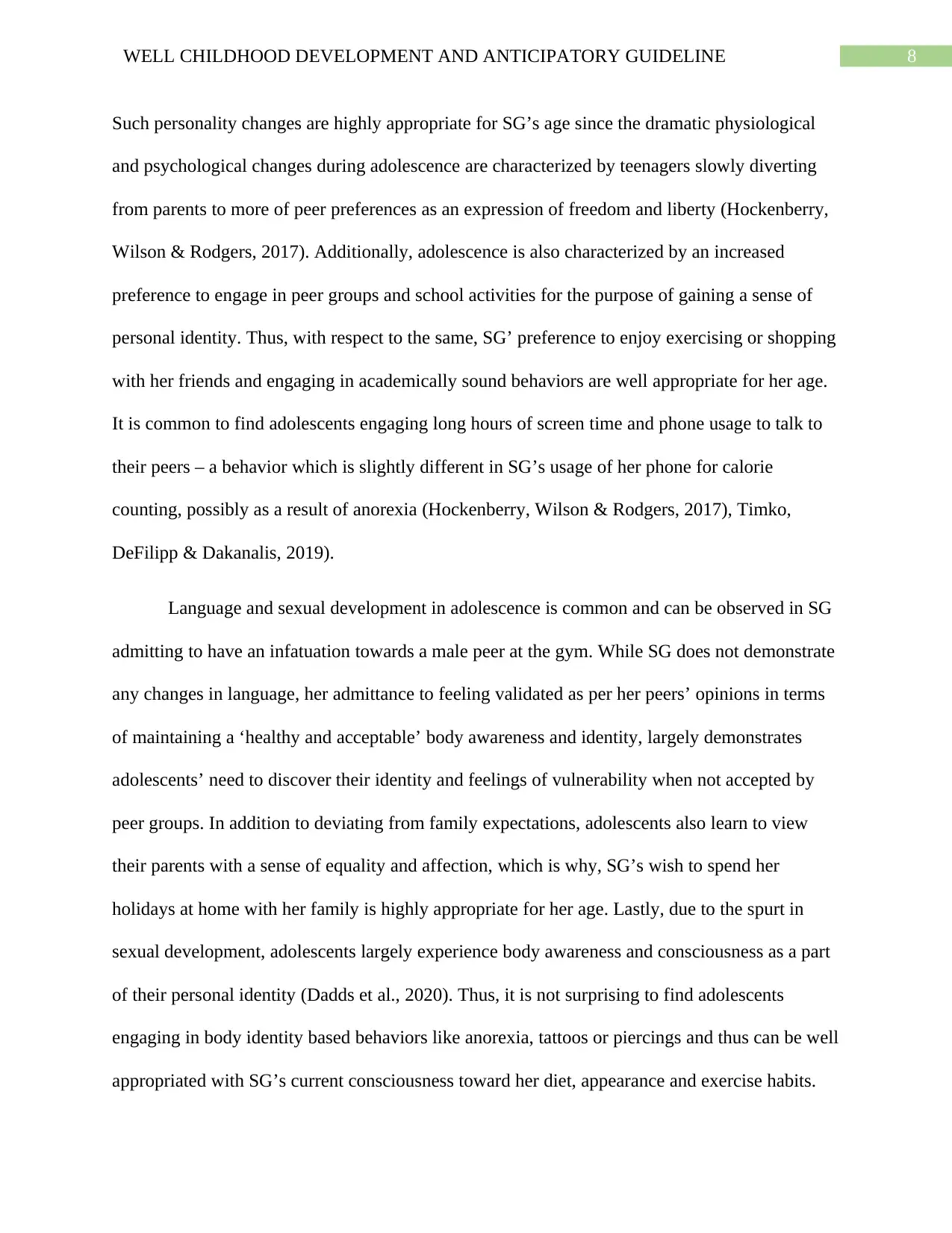
8WELL CHILDHOOD DEVELOPMENT AND ANTICIPATORY GUIDELINE
Such personality changes are highly appropriate for SG’s age since the dramatic physiological
and psychological changes during adolescence are characterized by teenagers slowly diverting
from parents to more of peer preferences as an expression of freedom and liberty (Hockenberry,
Wilson & Rodgers, 2017). Additionally, adolescence is also characterized by an increased
preference to engage in peer groups and school activities for the purpose of gaining a sense of
personal identity. Thus, with respect to the same, SG’ preference to enjoy exercising or shopping
with her friends and engaging in academically sound behaviors are well appropriate for her age.
It is common to find adolescents engaging long hours of screen time and phone usage to talk to
their peers – a behavior which is slightly different in SG’s usage of her phone for calorie
counting, possibly as a result of anorexia (Hockenberry, Wilson & Rodgers, 2017), Timko,
DeFilipp & Dakanalis, 2019).
Language and sexual development in adolescence is common and can be observed in SG
admitting to have an infatuation towards a male peer at the gym. While SG does not demonstrate
any changes in language, her admittance to feeling validated as per her peers’ opinions in terms
of maintaining a ‘healthy and acceptable’ body awareness and identity, largely demonstrates
adolescents’ need to discover their identity and feelings of vulnerability when not accepted by
peer groups. In addition to deviating from family expectations, adolescents also learn to view
their parents with a sense of equality and affection, which is why, SG’s wish to spend her
holidays at home with her family is highly appropriate for her age. Lastly, due to the spurt in
sexual development, adolescents largely experience body awareness and consciousness as a part
of their personal identity (Dadds et al., 2020). Thus, it is not surprising to find adolescents
engaging in body identity based behaviors like anorexia, tattoos or piercings and thus can be well
appropriated with SG’s current consciousness toward her diet, appearance and exercise habits.
Such personality changes are highly appropriate for SG’s age since the dramatic physiological
and psychological changes during adolescence are characterized by teenagers slowly diverting
from parents to more of peer preferences as an expression of freedom and liberty (Hockenberry,
Wilson & Rodgers, 2017). Additionally, adolescence is also characterized by an increased
preference to engage in peer groups and school activities for the purpose of gaining a sense of
personal identity. Thus, with respect to the same, SG’ preference to enjoy exercising or shopping
with her friends and engaging in academically sound behaviors are well appropriate for her age.
It is common to find adolescents engaging long hours of screen time and phone usage to talk to
their peers – a behavior which is slightly different in SG’s usage of her phone for calorie
counting, possibly as a result of anorexia (Hockenberry, Wilson & Rodgers, 2017), Timko,
DeFilipp & Dakanalis, 2019).
Language and sexual development in adolescence is common and can be observed in SG
admitting to have an infatuation towards a male peer at the gym. While SG does not demonstrate
any changes in language, her admittance to feeling validated as per her peers’ opinions in terms
of maintaining a ‘healthy and acceptable’ body awareness and identity, largely demonstrates
adolescents’ need to discover their identity and feelings of vulnerability when not accepted by
peer groups. In addition to deviating from family expectations, adolescents also learn to view
their parents with a sense of equality and affection, which is why, SG’s wish to spend her
holidays at home with her family is highly appropriate for her age. Lastly, due to the spurt in
sexual development, adolescents largely experience body awareness and consciousness as a part
of their personal identity (Dadds et al., 2020). Thus, it is not surprising to find adolescents
engaging in body identity based behaviors like anorexia, tattoos or piercings and thus can be well
appropriated with SG’s current consciousness toward her diet, appearance and exercise habits.
⊘ This is a preview!⊘
Do you want full access?
Subscribe today to unlock all pages.

Trusted by 1+ million students worldwide
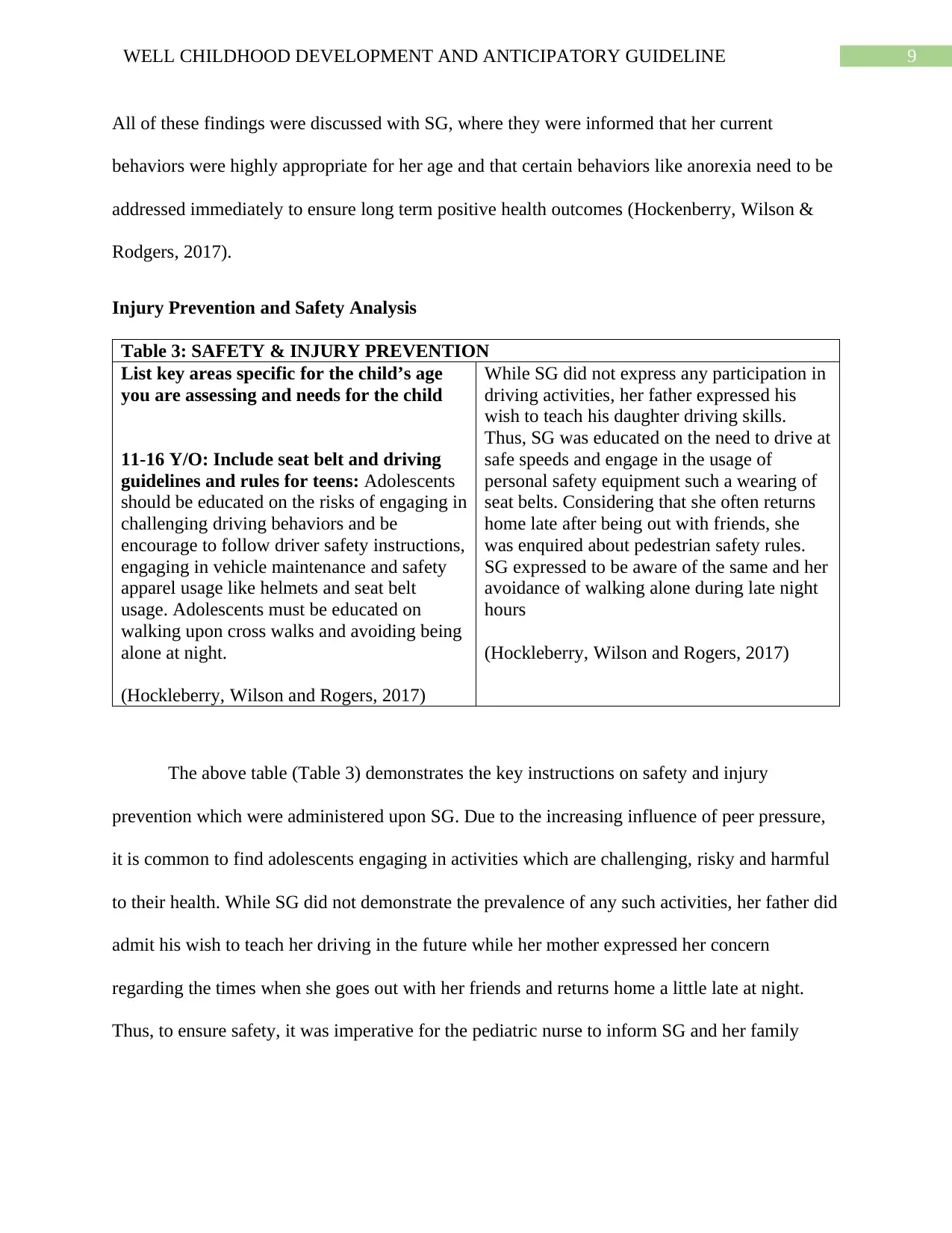
9WELL CHILDHOOD DEVELOPMENT AND ANTICIPATORY GUIDELINE
All of these findings were discussed with SG, where they were informed that her current
behaviors were highly appropriate for her age and that certain behaviors like anorexia need to be
addressed immediately to ensure long term positive health outcomes (Hockenberry, Wilson &
Rodgers, 2017).
Injury Prevention and Safety Analysis
Table 3: SAFETY & INJURY PREVENTION
List key areas specific for the child’s age
you are assessing and needs for the child
11-16 Y/O: Include seat belt and driving
guidelines and rules for teens: Adolescents
should be educated on the risks of engaging in
challenging driving behaviors and be
encourage to follow driver safety instructions,
engaging in vehicle maintenance and safety
apparel usage like helmets and seat belt
usage. Adolescents must be educated on
walking upon cross walks and avoiding being
alone at night.
(Hockleberry, Wilson and Rogers, 2017)
While SG did not express any participation in
driving activities, her father expressed his
wish to teach his daughter driving skills.
Thus, SG was educated on the need to drive at
safe speeds and engage in the usage of
personal safety equipment such a wearing of
seat belts. Considering that she often returns
home late after being out with friends, she
was enquired about pedestrian safety rules.
SG expressed to be aware of the same and her
avoidance of walking alone during late night
hours
(Hockleberry, Wilson and Rogers, 2017)
The above table (Table 3) demonstrates the key instructions on safety and injury
prevention which were administered upon SG. Due to the increasing influence of peer pressure,
it is common to find adolescents engaging in activities which are challenging, risky and harmful
to their health. While SG did not demonstrate the prevalence of any such activities, her father did
admit his wish to teach her driving in the future while her mother expressed her concern
regarding the times when she goes out with her friends and returns home a little late at night.
Thus, to ensure safety, it was imperative for the pediatric nurse to inform SG and her family
All of these findings were discussed with SG, where they were informed that her current
behaviors were highly appropriate for her age and that certain behaviors like anorexia need to be
addressed immediately to ensure long term positive health outcomes (Hockenberry, Wilson &
Rodgers, 2017).
Injury Prevention and Safety Analysis
Table 3: SAFETY & INJURY PREVENTION
List key areas specific for the child’s age
you are assessing and needs for the child
11-16 Y/O: Include seat belt and driving
guidelines and rules for teens: Adolescents
should be educated on the risks of engaging in
challenging driving behaviors and be
encourage to follow driver safety instructions,
engaging in vehicle maintenance and safety
apparel usage like helmets and seat belt
usage. Adolescents must be educated on
walking upon cross walks and avoiding being
alone at night.
(Hockleberry, Wilson and Rogers, 2017)
While SG did not express any participation in
driving activities, her father expressed his
wish to teach his daughter driving skills.
Thus, SG was educated on the need to drive at
safe speeds and engage in the usage of
personal safety equipment such a wearing of
seat belts. Considering that she often returns
home late after being out with friends, she
was enquired about pedestrian safety rules.
SG expressed to be aware of the same and her
avoidance of walking alone during late night
hours
(Hockleberry, Wilson and Rogers, 2017)
The above table (Table 3) demonstrates the key instructions on safety and injury
prevention which were administered upon SG. Due to the increasing influence of peer pressure,
it is common to find adolescents engaging in activities which are challenging, risky and harmful
to their health. While SG did not demonstrate the prevalence of any such activities, her father did
admit his wish to teach her driving in the future while her mother expressed her concern
regarding the times when she goes out with her friends and returns home a little late at night.
Thus, to ensure safety, it was imperative for the pediatric nurse to inform SG and her family
Paraphrase This Document
Need a fresh take? Get an instant paraphrase of this document with our AI Paraphraser
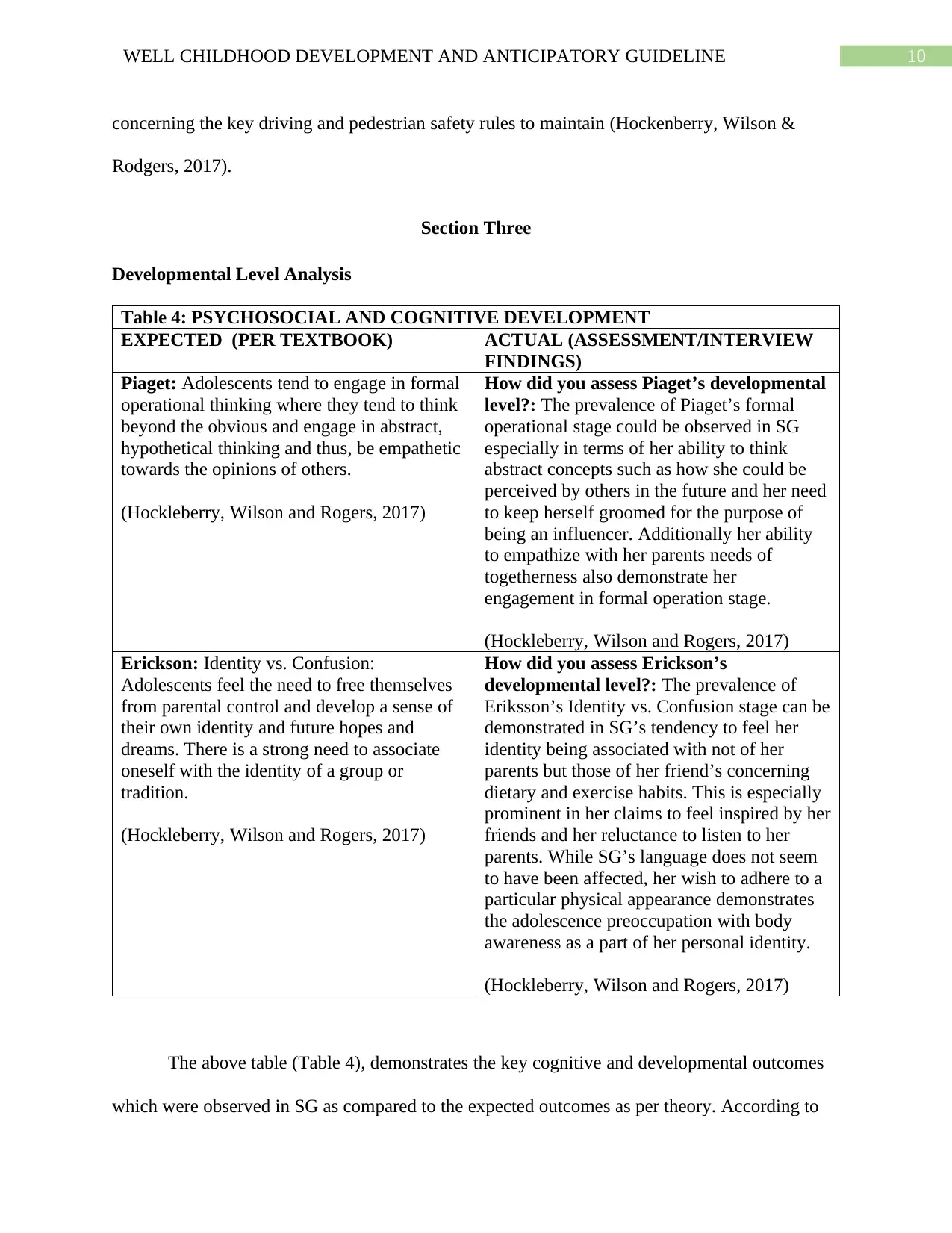
10WELL CHILDHOOD DEVELOPMENT AND ANTICIPATORY GUIDELINE
concerning the key driving and pedestrian safety rules to maintain (Hockenberry, Wilson &
Rodgers, 2017).
Section Three
Developmental Level Analysis
Table 4: PSYCHOSOCIAL AND COGNITIVE DEVELOPMENT
EXPECTED (PER TEXTBOOK) ACTUAL (ASSESSMENT/INTERVIEW
FINDINGS)
Piaget: Adolescents tend to engage in formal
operational thinking where they tend to think
beyond the obvious and engage in abstract,
hypothetical thinking and thus, be empathetic
towards the opinions of others.
(Hockleberry, Wilson and Rogers, 2017)
How did you assess Piaget’s developmental
level?: The prevalence of Piaget’s formal
operational stage could be observed in SG
especially in terms of her ability to think
abstract concepts such as how she could be
perceived by others in the future and her need
to keep herself groomed for the purpose of
being an influencer. Additionally her ability
to empathize with her parents needs of
togetherness also demonstrate her
engagement in formal operation stage.
(Hockleberry, Wilson and Rogers, 2017)
Erickson: Identity vs. Confusion:
Adolescents feel the need to free themselves
from parental control and develop a sense of
their own identity and future hopes and
dreams. There is a strong need to associate
oneself with the identity of a group or
tradition.
(Hockleberry, Wilson and Rogers, 2017)
How did you assess Erickson’s
developmental level?: The prevalence of
Eriksson’s Identity vs. Confusion stage can be
demonstrated in SG’s tendency to feel her
identity being associated with not of her
parents but those of her friend’s concerning
dietary and exercise habits. This is especially
prominent in her claims to feel inspired by her
friends and her reluctance to listen to her
parents. While SG’s language does not seem
to have been affected, her wish to adhere to a
particular physical appearance demonstrates
the adolescence preoccupation with body
awareness as a part of her personal identity.
(Hockleberry, Wilson and Rogers, 2017)
The above table (Table 4), demonstrates the key cognitive and developmental outcomes
which were observed in SG as compared to the expected outcomes as per theory. According to
concerning the key driving and pedestrian safety rules to maintain (Hockenberry, Wilson &
Rodgers, 2017).
Section Three
Developmental Level Analysis
Table 4: PSYCHOSOCIAL AND COGNITIVE DEVELOPMENT
EXPECTED (PER TEXTBOOK) ACTUAL (ASSESSMENT/INTERVIEW
FINDINGS)
Piaget: Adolescents tend to engage in formal
operational thinking where they tend to think
beyond the obvious and engage in abstract,
hypothetical thinking and thus, be empathetic
towards the opinions of others.
(Hockleberry, Wilson and Rogers, 2017)
How did you assess Piaget’s developmental
level?: The prevalence of Piaget’s formal
operational stage could be observed in SG
especially in terms of her ability to think
abstract concepts such as how she could be
perceived by others in the future and her need
to keep herself groomed for the purpose of
being an influencer. Additionally her ability
to empathize with her parents needs of
togetherness also demonstrate her
engagement in formal operation stage.
(Hockleberry, Wilson and Rogers, 2017)
Erickson: Identity vs. Confusion:
Adolescents feel the need to free themselves
from parental control and develop a sense of
their own identity and future hopes and
dreams. There is a strong need to associate
oneself with the identity of a group or
tradition.
(Hockleberry, Wilson and Rogers, 2017)
How did you assess Erickson’s
developmental level?: The prevalence of
Eriksson’s Identity vs. Confusion stage can be
demonstrated in SG’s tendency to feel her
identity being associated with not of her
parents but those of her friend’s concerning
dietary and exercise habits. This is especially
prominent in her claims to feel inspired by her
friends and her reluctance to listen to her
parents. While SG’s language does not seem
to have been affected, her wish to adhere to a
particular physical appearance demonstrates
the adolescence preoccupation with body
awareness as a part of her personal identity.
(Hockleberry, Wilson and Rogers, 2017)
The above table (Table 4), demonstrates the key cognitive and developmental outcomes
which were observed in SG as compared to the expected outcomes as per theory. According to
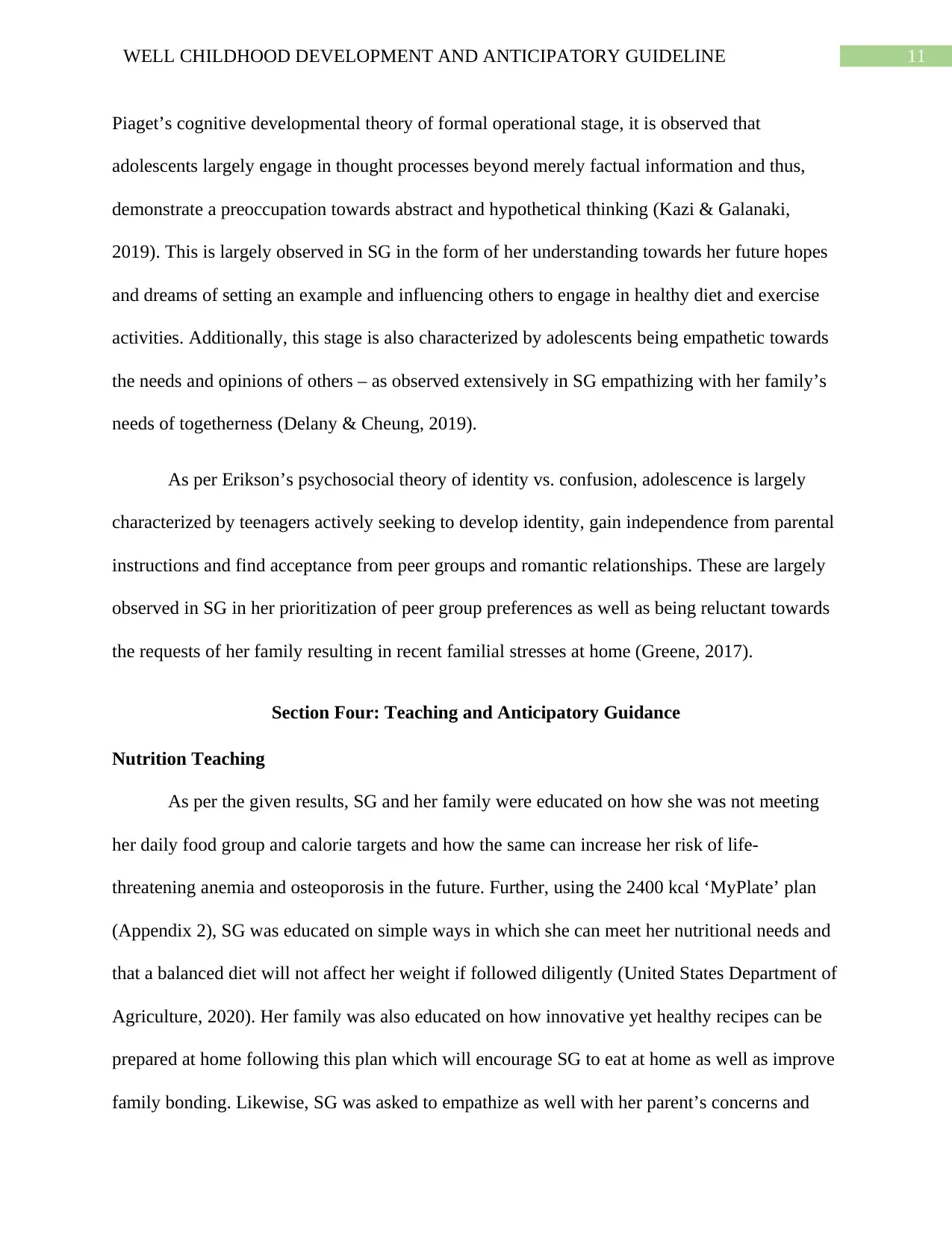
11WELL CHILDHOOD DEVELOPMENT AND ANTICIPATORY GUIDELINE
Piaget’s cognitive developmental theory of formal operational stage, it is observed that
adolescents largely engage in thought processes beyond merely factual information and thus,
demonstrate a preoccupation towards abstract and hypothetical thinking (Kazi & Galanaki,
2019). This is largely observed in SG in the form of her understanding towards her future hopes
and dreams of setting an example and influencing others to engage in healthy diet and exercise
activities. Additionally, this stage is also characterized by adolescents being empathetic towards
the needs and opinions of others – as observed extensively in SG empathizing with her family’s
needs of togetherness (Delany & Cheung, 2019).
As per Erikson’s psychosocial theory of identity vs. confusion, adolescence is largely
characterized by teenagers actively seeking to develop identity, gain independence from parental
instructions and find acceptance from peer groups and romantic relationships. These are largely
observed in SG in her prioritization of peer group preferences as well as being reluctant towards
the requests of her family resulting in recent familial stresses at home (Greene, 2017).
Section Four: Teaching and Anticipatory Guidance
Nutrition Teaching
As per the given results, SG and her family were educated on how she was not meeting
her daily food group and calorie targets and how the same can increase her risk of life-
threatening anemia and osteoporosis in the future. Further, using the 2400 kcal ‘MyPlate’ plan
(Appendix 2), SG was educated on simple ways in which she can meet her nutritional needs and
that a balanced diet will not affect her weight if followed diligently (United States Department of
Agriculture, 2020). Her family was also educated on how innovative yet healthy recipes can be
prepared at home following this plan which will encourage SG to eat at home as well as improve
family bonding. Likewise, SG was asked to empathize as well with her parent’s concerns and
Piaget’s cognitive developmental theory of formal operational stage, it is observed that
adolescents largely engage in thought processes beyond merely factual information and thus,
demonstrate a preoccupation towards abstract and hypothetical thinking (Kazi & Galanaki,
2019). This is largely observed in SG in the form of her understanding towards her future hopes
and dreams of setting an example and influencing others to engage in healthy diet and exercise
activities. Additionally, this stage is also characterized by adolescents being empathetic towards
the needs and opinions of others – as observed extensively in SG empathizing with her family’s
needs of togetherness (Delany & Cheung, 2019).
As per Erikson’s psychosocial theory of identity vs. confusion, adolescence is largely
characterized by teenagers actively seeking to develop identity, gain independence from parental
instructions and find acceptance from peer groups and romantic relationships. These are largely
observed in SG in her prioritization of peer group preferences as well as being reluctant towards
the requests of her family resulting in recent familial stresses at home (Greene, 2017).
Section Four: Teaching and Anticipatory Guidance
Nutrition Teaching
As per the given results, SG and her family were educated on how she was not meeting
her daily food group and calorie targets and how the same can increase her risk of life-
threatening anemia and osteoporosis in the future. Further, using the 2400 kcal ‘MyPlate’ plan
(Appendix 2), SG was educated on simple ways in which she can meet her nutritional needs and
that a balanced diet will not affect her weight if followed diligently (United States Department of
Agriculture, 2020). Her family was also educated on how innovative yet healthy recipes can be
prepared at home following this plan which will encourage SG to eat at home as well as improve
family bonding. Likewise, SG was asked to empathize as well with her parent’s concerns and
⊘ This is a preview!⊘
Do you want full access?
Subscribe today to unlock all pages.

Trusted by 1+ million students worldwide
1 out of 19
Related Documents
Your All-in-One AI-Powered Toolkit for Academic Success.
+13062052269
info@desklib.com
Available 24*7 on WhatsApp / Email
![[object Object]](/_next/static/media/star-bottom.7253800d.svg)
Unlock your academic potential
Copyright © 2020–2025 A2Z Services. All Rights Reserved. Developed and managed by ZUCOL.




